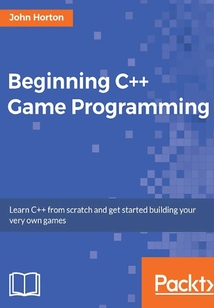舉報 

會員
Beginning C++ Game Programming
最新章節:
Thanks!
Thisbookisperfectforyouifanyofthefollowingdescribesyou:YouhavenoC++programmingknowledgewhatsoeverorneedabeginnerlevelrefreshercourse,ifyouwanttolearntobuildgamesorjustusegamesasanengagingwaytolearnC++,ifyouhaveaspirationstopublishagameoneday,perhapsonSteam,orifyoujustwanttohaveloadsoffunandimpressfriendswithyourcreations.
最新章節
- Thanks!
- Chapter 17. Before you go...
- Summary
- OpenGL shaders and GLSL
- Building a particle system
- The SFML Drawable class
品牌:中圖公司
上架時間:2021-07-08 09:32:07
出版社:Packt Publishing
本書數字版權由中圖公司提供,并由其授權上海閱文信息技術有限公司制作發行
- Thanks! 更新時間:2021-07-08 11:13:53
- Chapter 17. Before you go...
- Summary
- OpenGL shaders and GLSL
- Building a particle system
- The SFML Drawable class
- Chapter 16. Extending SFML Classes Particle Systems and Shaders
- Summary
- Using the HUD class
- The HUD class
- Playing sounds
- Populating the sound emitters
- Adding SoundManager to the game engine
- Building the SoundManager class
- How SFML handles spatialization
- What is Spatialization?
- Chapter 15. Sound Spatialization and HUD
- Summary
- Collision detection
- Updating the engine
- Coding the loadLevel function
- Building the LevelManager class
- Designing some levels
- Chapter 14. Building Playable Levels and Collision Detection
- Summary
- FAQ
- Updating the game engine to use Thomas and Bob
- Building the Thomas and Bob classes
- Building the PlayableCharacter class
- Abstract classes - virtual and pure virtual functions
- Polymorphism
- Inheritance
- Chapter 13. Advanced OOP – Inheritance and Polymorphism
- Summary
- FAQ
- Coding the main function
- Building the game engine
- Structuring the Thomas Was Late code
- The Thomas Was Late game
- Chapter 12. Abstraction and Code Management – Making Better Use of OOP
- Summary
- FAQ
- Playing the rest of the sounds
- Restarting the game
- Leveling up
- Preparing sound effects
- Saving and loading the high-score
- Chapter 11. Sound Effects File I/O and Finishing the Game
- Summary
- FAQ
- Drawing the HUD and the home and level up screens
- Updating the HUD each frame
- Adding all the Text and HUD objects
- Chapter 10. Layering Views and Implementing the HUD
- Summary
- FAQ
- Detecting collisions
- Using the Pickup class
- Coding a class for pickups
- Giving the player a crosshair
- Making the bullets fly
- Coding the Bullet class
- Chapter 9. Collision Detection Pickups and Bullets
- Summary
- FAQ
- Using the TextureHolder class for all textures
- Building a horde of zombies
- The TextureHolder Class
- The Standard Template Library
- Pointers
- Chapter 8. Pointers the Standard Template Library and Texture Management
- Summary
- FAQ
- Using the background
- Creating a randomly generated scrolling background
- SFML vertex arrays and sprite sheets
- C++ References
- Chapter 7. C++ References Sprite Sheets and Vertex Arrays
- Summary
- FAQ
- Starting coding the main game loop
- Managing the code files
- Starting the Zombie Arena game engine
- Controlling the game camera with SFML View
- Building the Player-the first class
- OOP
- Planning and starting the Zombie Arena game
- Chapter 6. Object-Oriented Programming Classes and SFML Views
- Summary
- FAQ
- Improving the game and the code
- Simple sound FX
- Handling death
- Handling the player's input
- Drawing the player and other sprites
- Preparing the player (and other sprites)
- Chapter 5. Collisions Sound and End Conditions – Making the Game Playable
- Summary
- FAQ
- Growing the branches
- Getting started with functions
- Class enumerations
- Making decisions with switch
- Arrays
- Loops
- Chapter 4. Loops Arrays Switch Enumerations and Functions – Implementing Game Mechanics
- Summary
- FAQ
- Adding a time bar
- Adding a score and a message
- SFML Text and Font
- C++ strings
- Pausing and restarting the game
- Chapter 3. C++ Strings SFML Time Player Input and HUD
- Summary
- FAQ
- Moving the clouds and the bee
- Timing
- Making decisions with if and else
- Random numbers
- Adding clouds a tree and a buzzing bee
- Manipulating variables
- C++ variables
- Chapter 2. Variables Operators and Decisions – Animating Sprites
- Summary
- FAQ
- Handling errors
- Drawing the game background
- The main game loop
- Opening a window using SFML
- Starting to code the game
- Understanding screen and internal coordinates
- Project assets
- Creating a project from the template
- Planning Timber!!!
- Setting up the development environment
- SFML
- Microsoft Visual Studio
- Meet C++
- The games
- Chapter 1. C++ SFML Visual Studio and Starting the First Game
- Customer support
- Reader feedback
- Conventions
- Who this book is for
- What you need for this book
- What this book covers
- Thomas was Late
- Zombie Arena
- Timber!!!
- Preface
- Dedication
- eBooks discount offers and more
- www.PacktPub.com
- About the Reviewer
- About the Author
- Credits
- 版權頁
- 封面
- 封面
- 版權頁
- Credits
- About the Author
- About the Reviewer
- www.PacktPub.com
- eBooks discount offers and more
- Dedication
- Preface
- Timber!!!
- Zombie Arena
- Thomas was Late
- What this book covers
- What you need for this book
- Who this book is for
- Conventions
- Reader feedback
- Customer support
- Chapter 1. C++ SFML Visual Studio and Starting the First Game
- The games
- Meet C++
- Microsoft Visual Studio
- SFML
- Setting up the development environment
- Planning Timber!!!
- Creating a project from the template
- Project assets
- Understanding screen and internal coordinates
- Starting to code the game
- Opening a window using SFML
- The main game loop
- Drawing the game background
- Handling errors
- FAQ
- Summary
- Chapter 2. Variables Operators and Decisions – Animating Sprites
- C++ variables
- Manipulating variables
- Adding clouds a tree and a buzzing bee
- Random numbers
- Making decisions with if and else
- Timing
- Moving the clouds and the bee
- FAQ
- Summary
- Chapter 3. C++ Strings SFML Time Player Input and HUD
- Pausing and restarting the game
- C++ strings
- SFML Text and Font
- Adding a score and a message
- Adding a time bar
- FAQ
- Summary
- Chapter 4. Loops Arrays Switch Enumerations and Functions – Implementing Game Mechanics
- Loops
- Arrays
- Making decisions with switch
- Class enumerations
- Getting started with functions
- Growing the branches
- FAQ
- Summary
- Chapter 5. Collisions Sound and End Conditions – Making the Game Playable
- Preparing the player (and other sprites)
- Drawing the player and other sprites
- Handling the player's input
- Handling death
- Simple sound FX
- Improving the game and the code
- FAQ
- Summary
- Chapter 6. Object-Oriented Programming Classes and SFML Views
- Planning and starting the Zombie Arena game
- OOP
- Building the Player-the first class
- Controlling the game camera with SFML View
- Starting the Zombie Arena game engine
- Managing the code files
- Starting coding the main game loop
- FAQ
- Summary
- Chapter 7. C++ References Sprite Sheets and Vertex Arrays
- C++ References
- SFML vertex arrays and sprite sheets
- Creating a randomly generated scrolling background
- Using the background
- FAQ
- Summary
- Chapter 8. Pointers the Standard Template Library and Texture Management
- Pointers
- The Standard Template Library
- The TextureHolder Class
- Building a horde of zombies
- Using the TextureHolder class for all textures
- FAQ
- Summary
- Chapter 9. Collision Detection Pickups and Bullets
- Coding the Bullet class
- Making the bullets fly
- Giving the player a crosshair
- Coding a class for pickups
- Using the Pickup class
- Detecting collisions
- FAQ
- Summary
- Chapter 10. Layering Views and Implementing the HUD
- Adding all the Text and HUD objects
- Updating the HUD each frame
- Drawing the HUD and the home and level up screens
- FAQ
- Summary
- Chapter 11. Sound Effects File I/O and Finishing the Game
- Saving and loading the high-score
- Preparing sound effects
- Leveling up
- Restarting the game
- Playing the rest of the sounds
- FAQ
- Summary
- Chapter 12. Abstraction and Code Management – Making Better Use of OOP
- The Thomas Was Late game
- Structuring the Thomas Was Late code
- Building the game engine
- Coding the main function
- FAQ
- Summary
- Chapter 13. Advanced OOP – Inheritance and Polymorphism
- Inheritance
- Polymorphism
- Abstract classes - virtual and pure virtual functions
- Building the PlayableCharacter class
- Building the Thomas and Bob classes
- Updating the game engine to use Thomas and Bob
- FAQ
- Summary
- Chapter 14. Building Playable Levels and Collision Detection
- Designing some levels
- Building the LevelManager class
- Coding the loadLevel function
- Updating the engine
- Collision detection
- Summary
- Chapter 15. Sound Spatialization and HUD
- What is Spatialization?
- How SFML handles spatialization
- Building the SoundManager class
- Adding SoundManager to the game engine
- Populating the sound emitters
- Playing sounds
- The HUD class
- Using the HUD class
- Summary
- Chapter 16. Extending SFML Classes Particle Systems and Shaders
- The SFML Drawable class
- Building a particle system
- OpenGL shaders and GLSL
- Summary
- Chapter 17. Before you go...
- Thanks! 更新時間:2021-07-08 11:13:53


